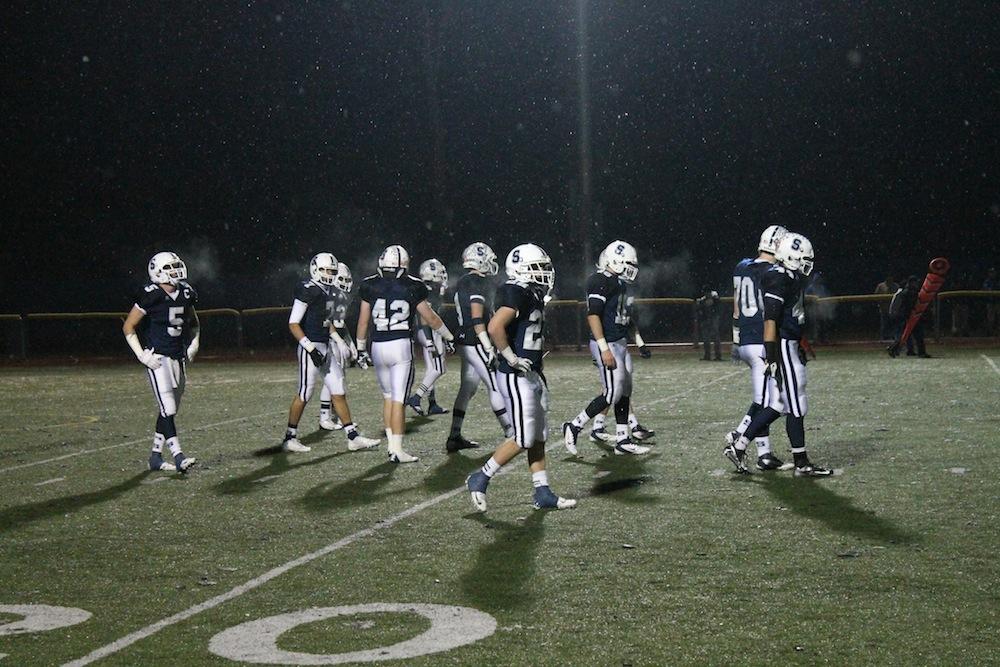It’s four hours until game time. Matson has to get mentally prepared, physically prepared. He has to have enough energy to last him through the game and still carry his own weight on the squad. He needs to look good in front of the fans.
He pulls his uniform from his closet and lays it out on his bed: shorts, a white undershirt, and a red shirt with BMHS, for Brien McMahon High School, emblazoned on his chest above a small white star.
Although he will be hitting the gridiron today, he won’t be wearing a helmet. He’ll be riling up the crowd.
Yes, Ivan Matson, a senior boy at McMahon High School, is a cheerleader.
“I don’t do the jumps or the cheering. I save that for the girls,” Matson said. “I’m more into throwing them up in the air and doing those kinds of cool stunts.”
However, at Staples, the male cheerleading scene is a different one.
According to Athletic Director Marty Lisevick, in his 12 years at Staples, just one boy has participated in the cheerleading program, who actually went on to cheer at Villanova University.
That one boy was Zachary Cohen ’01 who, in addition to Staples and Villanova cheered on high school teams in Pennsylvania and Kentucky, and is currently coaching in California.
According to Cohen, in UCA College Nationals, there is a limit to how many male cheerleaders can be on a team: for teams comprised of 16 cheerleaders, no more than nine can be male.
“The general thought here is that having more male cheerleaders is an unfair advantage,” Cohen said. “The really competitive collegiate teams often have more guys than girls out on the competition floor.”
In fact, according to Wikipedia, although an overwhelming 97% of high school cheerleaders are female, when cheering reaches the collegiate level that number depletes to just 50%, leaving the other half of college cheerleaders as guys.
In addition, according to Cohen and the sources on Wikipedia, cheerleading was initially an all-male sport up until the time of the World Wars. From 1898 to 1923, males dominated the cheerleading world.
Still, that doesn’t change today’s society and the fact that today Staples is lacking male cheerleading—perhaps in part because of the common stereotype of homosexuality that turns some away.
One Staples student said when he thinks of male cheerleaders he thinks they’re “weird.”
“Usually it’s hyped up as a women’s sport,” the anonymous student said.
As a result, cheerleading seems to another Staples student as “gay or just really feminine.”
“A lot of cheerleading is just supporting the football and basketball teams. It’s girls supporting guys,” the second anonymous student said. “It just seems out of place if a guy is cheerleading.”
Matson says he can cite one specific time where he and fellow male cheerleader J.P. Consiglio heard “homo” chants from their own Norwalk crowd.
Even though Cohen never heard anything from his home crowd, he recalls the out-of-town teams shouting at him.
“Most of the teasing I got was not in school, but rather others outside of school not understanding what I did,” Cohen said. “The real issues were when we traveled. There were some schools that we visited that weren’t as accepting.”
As for Staples, according to Cohen, it was quite the opposite.
“Staples actually wasn’t that bad,” Cohen said. “There might have been some people who didn’t completely understand what I was doing, but for the most part people were pretty supportive and tolerant.”
Nonetheless, according to Consiglio, the reputation used to be one of his concerns—he was actually worried when he began a year ago.
“I soon came to realize that if anyone thinks cheerleading is gay they are sadly mistaken,” Consiglio said.
Staples cheerleader Maddy Mann ’13, who also cheers on two co-ed travel teams, agrees.
“When I think of male cheerleaders I don’t think of their sexuality,” Mann said. “I think more about them being the leaders of the team and some of the strongest players.”
Still, the stereotype persists and affects participation in the sport, Staples and McMahon cheerleaders said. According to Mann, even though there are some guys on her travel teams, she can only recall seeing four male cheerleaders in the FCIAC all last year—a number she attributes to the current socially acceptable values. Matson said he counted seven, including the five guys on his team.
“The only thing I have to say about what’s socially acceptable in sporting culture is equality,” Consiglio said. “If a guy wants to cheerlead, let him. If a girl wants to be a linebacker, by all means.”
In any case, Matson isn’t concerned about stereotyping or reputation. Whatever happens, he has his teammates.
“I know the guys have my back,” Matson said. “I have their back, they have mine. That’s just how it goes. We’re part of a team.”
And according to Matson that’s just what it is—a team.
“I don’t play a fall sport, and honestly there are lots of attractive girls on the team,” Matson said. “It was pretty easy to make the decision to join the team, and I’d say it’s been a pretty good decision, too.”
Since joining the team at the end of last year, Matson says he has not only befriended girls who he wouldn’t necessarily have even known had he not joined the team, he has also become much closer with the other four boys on the team, Ian Daves, Carlos Rivas, Jake Balboa, and Consiglio.
“All of my current friends love the fact I’m a cheerleader, they always tell me how good I have it, surrounded by girls all the time,” Consiglio said. “I haven’t lost any friends, but made a lot of new ones during this process.”
Unlike other team activities, in cheerleading it is necessary to build up that high foundation of trust.
“It’s not exactly like any other sport in that way,” Matson said. “You have to trust someone enough to throw you up in the air and catch you. That says something.”
In addition to the danger of the stunts, the amount of time spent together is a factor in bringing everyone closer, according to Matson and Consiglio. They say a typical week of cheering consists of around four practices a week at three hours a practice, plus a game on the weekends.
However, there are differences between the guys and girls on the team. According to Mann, the sport comes easier to the male cheerleaders than it does for the girls.
“That’s not to say they don’t work as hard or it’s an easy sport, but they catch on faster,” Mann said. “A male cheerleader brings a lot of strength to the team.”
Cohen agrees, saying in general the males tend to be stronger, making them better stunters and tumblers.
“Cheerleading has three main components for male cheerleaders,” Cohen said. “Throwing other people around, known as stunting, throwing myself around, tumbling, and yelling the cheers very loudly. All of them require training and the first two require a great deal of strength and physical skill.”
Mann also says aside from metaphorical strength, male cheerleaders bring a lot of physical strength as well, being able to lift girls up ten feet in the air. She adds that male cheerleaders are typically skilled tumblers because of the amount of power they possess.
Consiglio and Matson both are back spots, a position on the squad that requires them to catch and throw the flyers. Their strength coupled with the light weight of the other cheerleaders makes for easy work, according to the McMahon cheerleaders.
But throughout their differences, their focus is still the same. Whether it’s stretching pre-practice, or “trying not to look stupid in front of a crowd,” Matson, Consiglio, and the rest of the Brien McMahon cheerleaders are just looking to finish out the season strong.
“At the end of the day,” Matson said, “we’re all cheerleaders and we have to stick together.”














































